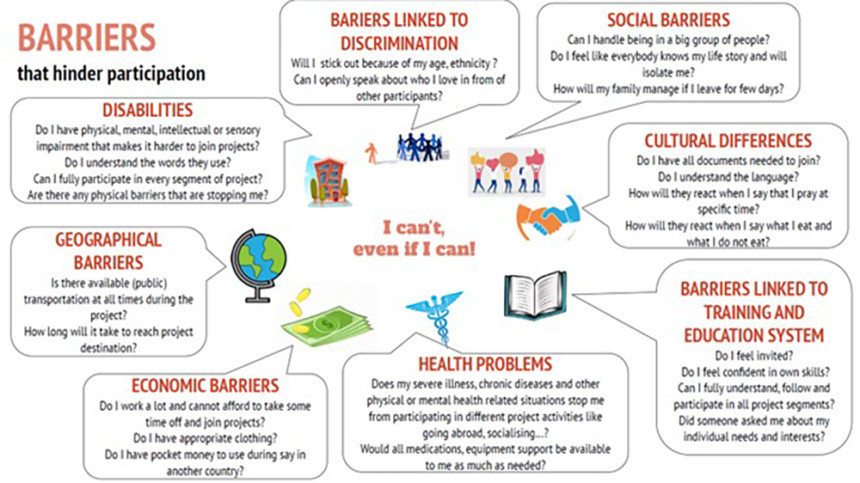
Inclusion requires a barrier analysis
To truly achieve inclusion, finding out what hinders the participation of people with fewer opportunities is essential. A barrier analysis is a valuable tool for identifying those barriers.
In the blog text “Inclusion and diversity in projects: what to consider?” I provided a model for an inclusive project design that was presented in a Croatian Erasmus+ office organised workshop Embracing Inclusion and Diversity in your Erasmus+ projects, in Zagreb, Croatia, on 15-17 November 2022.
In this blog, I continue with the presentation of barrier analysis, a tool that can be used to identify barriers that stand in the way of an inclusive project.
People with fewer opportunities
Before starting with the barrier analysis, it is good to think who are vulnerable in the desired project context. Generally, these are people who are at a disadvantage compared to their peers because they face one or more of the exclusion factors and obstacles. These can prevent them from taking part in employment, formal and non-formal education, transnational mobility, democratic process, and society at large.
Hence, it is useful to call them people with fewer opportunities due to the multiple insecurities they may face, the persistence of these situations and the fact that this leads to the erosion of their rights and responsibilities.
Barriers to participation
There are many barriers that can hinder participation. These can be analysed by asking questions and identifying how one is capable of participating despite the barrier.
As shown in the picture below, the barriers can relate to e.g., social, cultural, economic, and geographical barriers, or to discrimination, health, disabilities or training and education system.
There are many barriers that can hinder participation.
Thus, barriers are not only related to people with disabilities or minority groups, but they can be multiple and intersecting. They can be faced by people who are not immediately identified as people with fewer opportunities.
It is also good to note that being in one of these situations does not necessarily lead to fewer opportunities (e.g., not all people from minorities are discriminated) and varies according to country and context (e.g., being a gay person is different in Berlin, Helsinki or some rural place or illegal as in Uganda).
Hence, it is important to focus on the situations people are facing rather than on stigmatization or blaming people. Through this, we can, in our projects, focus on the obstacles that need to be removed and support that is required and by this make an impact.

Picture 1. Agency for Mobility and EU Programmes, Erasmus+ Office, Croatia.
Useful tool for a project planner
Before starting to draft the project proposal for inclusion, it is advisable to identify the target group. With the target group defined, it is easier to conduct the barrier analysis based on the picture above.
In the barrier analysis, it is good to go through each of the categories from the viewpoint of the target group and to list the barriers they might encounter but also aim to identify how they can participate despite the barrier: to focus on the “I can!” aspect of the picture.
Once the barriers are identified, it is possible to search for solutions. As an example of the barrier ‘Young people are not aware that they have the right to participate or underestimate the value of their own voice’, the solution to the barrier could be ‘Young people should be made aware that it is their right to participate and be included’.
Once the barriers are identified, it is possible to search for solutions.
After that, one can think about how to best make young people aware of their rights in the context where the project is going to take place. If the solution is to organize a meeting for the youth, the barrier analysis can also assist in planning the meeting inclusive.
It is advisable to select the right venue at the right time and to seek young people’s input. It should be easy to get to and fully accessible. This means that accessibility does not only refer to getting to the building, but also that everyone’s needs are accounted for once they are there – appropriate bathroom facilities, quiet spaces and signage are just few examples for the venue.
As explained through the example, a barrier analysis can be a helpful tool in different phases of the project, not only in the planning phase. Once going forward with the implementation, it is good to double-check the activities from the lens of barrier analysis as well as when seeking feedback from the target group.
The blog post is based on the sources provided by Council for Disabled Children in the UK and Erasmus+ Office in Croatia.
Permanent address: http://urn.fi/URN:NBN:fi-fe202301021081